



MOO AGA34
Sakkra, Impossible, Medium, 5 Opponents
This game of Master of Orion was inspired by joining the OSG29A succession game at Realms Beyond. I was having fun playing a few turns of this old classic, and decided to set up a solo venture of my own. I wasn't planning on writing about this game, and indeed for all the Master of Orion writings that I have on this website, I have about twice as many games that I didn't end up reporting on. However, this turned into such an interesting scenario that I ended up documenting it with screenshots, and eventually decided to turn it into this report. Yeah sure, why not. There hasn't been a new written MOO report on this website in years, right? This is the reason why the early parts of this report are missing screenshots; hopefully the overview maps are enough to follow what's going on.
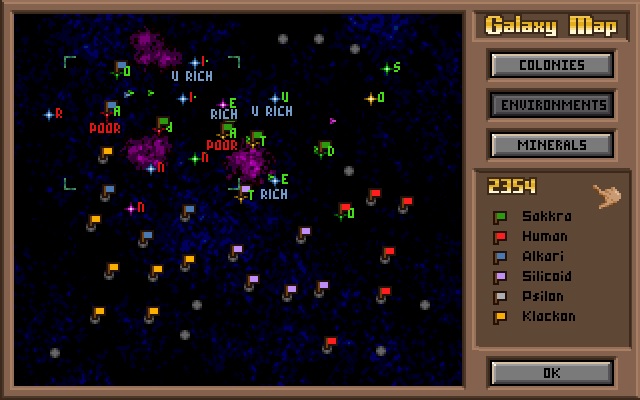
Sssla appeared just north of the center of the map near a midsized nebula. The planet was not actually in the nebula itself, although travel to the south would be a major pain for me in this game. There was only one planet within 3 parsecs, which turned out to be an Arid 65 planet just to the west that rolled Poor status. Argh, I always hate having a Poor planet for the second colony. You can use those things for research and sending population to other worlds, but that's about it, and the Sakkra don't even have that much of a need for population transportation with their innate growth bonus. (You should still do so, of course, it's just not as useful for them as with other races.) Just on the south side of the nebula was a Terran planet size 120 - wow! It was 4 parsecs away, and that would be my immediate first target for this game. Now why couldn't that have been the planet right next to Sssla? Reverse those two worlds and this game would have been an order of magnitude easier.
Further scouting revealed an unusual local neighborhood. There were only two other habitable planets within range, a Desert 40 planet at five parsecs off to the east and a Jungle 85 planet off to the west, also five parsecs away. Everything else came up Hostile, although this turned out to be a neighborhood of potentially excellent Hostile planets down the road. There was a Rich Dead world to the south, another Rich Dead planet to the northwest, an Ultra Rich Tundra planet to the north, and an Ultra Rich Inferno world further to the northwest. Even better, a lot of these planets were large in size for Hostile planets: the Dead Rich world to the northwest had a base size of 50, and the Ultra Rich Tundra planet had a base size of 55. If I could research enough Planetology tech to colonize those worlds, I would be in an excellent position.
I built factories at Sssla for about 15 turns, then opened up Planetology and Propulsion with a single turn's worth of full research to seed the initial investment. I needed additional range to expand, and for the Sakkra, getting Planetology going early on is always a worthwhile investment. I had no choice on the research options: Improve Eco Restoration and Range 5 techs. Those were both highly useful here, and I researched the two of them alongside factory construction at Sssla. I made no attempt to build factories at the Poor second colony, instead pushing research into those key techs. While I do like to max out Poor planets on factories so that they can stand up some missile bases, it wasn't worthwhile to do so here while I clearly needed to get some research going while also building factories at Sssla.
By the time that research finished and factories maxed at Sssla, it was roughly 2330 on the calendar. Unfortunately, I had suffered my first setback: the Silicoids had already colonized the Terran 120 planet to the south side of the nebula.  There was almost nothing I could do about this, as they settled there around roughly 2325 and I hadn't even had contact with them before that point. They simply appeared with a colony ship and laser fighter escorts out of nowhere and colonized the planet. That was a bad break. I cranked out one round of laser fighters and sent them to the Rich Dead planet in the south, just to stop the Silicoids from waltzing in there with a single colony ship and fighter escort. Then I built two colony ships for the Desert world to the east and the Jungle planet to the west. I just barely managed to get to the Desert planet ahead of the Humans, my scouts already chasing off some of their unarmed colony ships there. I had hoped that settling that planet would bring the Ocean world further to the northeast into range, but it turned out that the distance was still 6 parsecs. Argh, that would have been a huge help to reach those planets and open up the north for colonization, where it was clear by now that no one had started. Instead that area remained tantalizingly out of reach for the moment. At least I had a buffer zone of a lot of empty space over there. (The unscouted planet to the southeast of the Desert world was Orion.)
There was almost nothing I could do about this, as they settled there around roughly 2325 and I hadn't even had contact with them before that point. They simply appeared with a colony ship and laser fighter escorts out of nowhere and colonized the planet. That was a bad break. I cranked out one round of laser fighters and sent them to the Rich Dead planet in the south, just to stop the Silicoids from waltzing in there with a single colony ship and fighter escort. Then I built two colony ships for the Desert world to the east and the Jungle planet to the west. I just barely managed to get to the Desert planet ahead of the Humans, my scouts already chasing off some of their unarmed colony ships there. I had hoped that settling that planet would bring the Ocean world further to the northeast into range, but it turned out that the distance was still 6 parsecs. Argh, that would have been a huge help to reach those planets and open up the north for colonization, where it was clear by now that no one had started. Instead that area remained tantalizingly out of reach for the moment. At least I had a buffer zone of a lot of empty space over there. (The unscouted planet to the southeast of the Desert world was Orion.)
Over in the west, my extended range had revealed two more habitable planets further away, an Ocean planet and another Poor Arid world. I built a colony ship to claim that territory after settling the Jungle 85 location, only to see my scouts pushed away by the Alkari. The birds had brought colony ships plus well over 100 armed Small ships, and what could my scouts do about that? Not much while operating 10 parsecs away from Sssla, with a brand new fledgling colony at the Jungle world, and a Poor planet that had zero factories at the Arid planet.
Now this wouldn't have been too bad of a situation if I had been able to maintain peace, but that wasn't in the cards either. The Alkari kicked it off by declaring war on the turn after I met them. Ah, that classic birds vs lizards diplomatic relationship. We met on one turn, and then they declared war on the next interturn. Fun stuff. (This is the biggest reason why the Sakkra are only an average race in terms of power: their diplomatic situation is among the worst in the game.) An early game cheese alliance shortly brought the Klackons into this war on the side of the Alkari. Shortly thereafter, the Silicoids began their own independent war with me, and started targeting me from the south.
That was roughly the situation at the time of the screenshot above: at war with three of the four races that I had contact with, having essentially one fully-functioning planet to my name, and with little more than a promise of future strength down the road if I could manage to colonize additional territory. After getting out those initial colony ships, I had put Sssla onto research for a few turns, and fortunately did manage to research two very helpful techs in the second tier of Planetology and Propulsion: Controlled Dead (no choice) and Warp 2 engines (over Range 6 and Inertial Stabilizer). So now I had the ability to colonize three more planets, but Sssla was the only planet with any sort of production to turn out colony ships, and I also had to hold off the invading aliens at the borders with some mixture of cardboard cutouts and space magic. Oh, and I still hadn't even opened up the other four tech fields, much less researched anything in them. I had no weapons aside from lasers and nukes, no shields, nothing from the Construction field, nothing. My tech situation was beyond pathetic, and it was only going to get worse for the forseeable future.
Fortunately, the diplomatic situation wasn't quite as bad as it could have been. The Humans were nominated against the Klackons in the first Council election, and since the Klackons were already at war with me anyway, I could vote for the Humans and score huge diplomatic points with them. That took relations with the Humans up to "Affable", and with their Honorable personality, I could be reasonably sure that we would remain at peace. I signed the max trade agreement with them, and they eventually came asking for a Non Aggression pact, which I was happy to agree to. Having a calm border in the east was a huge help, and that allowed me to slowly max out the little Desert planet over there with factories over two or three dozen turns. It never came under attack until after I could get some bases finished. The Klackons were fortunately located too far away to do anything to me either. They had gotten into wars with a bunch of other races, including the Alkari and Silicoids, and they never sent a fleet towards me in the early game. Thanks goodness for that: they appeared to be the strongest AI, and I would have had a devil of a time stopping them. The Alkari similarly seemed more interested in clashing with the bugs than going after me. I had many nervous turns watching them move ships just to the west of my Jungle planet over there, and I couldn't be completely certain that they were heading somewhere else without an improved scanner. Still, I was measuring their movement between turns very closely, and it didn't look like I was the target. I kept my Jungle world on factory construction, and it too was never attacked until after I had maxed it out and begun missile base construction.
The Silicoids were therefore the only race that sent their main forces against me, but they were in full fledged hot war and I would face the brunt of their aggression. My first colony ship after researching Controlled Dead tech had gone to the Rich world to my south, where my laser fighters (swelled in size to about 50 by now) had chased off a half dozen Silicoid colony ships already. I settled the planet and started building it up, but the nebula between that world and Sssla made movement very difficult. I also lacked any Reserve to stand up the planet faster, and I could not put Sssla onto feeding it, not when I was desperately building colony ships for the Rich Dead world and Ultra Rich Tundra world to the north. Less than half a dozen turns after colonizing the planet in the south, the Silicoids brought their main fleet and chased away my laser fighters. 50 Small laser ships don't win against a half dozen Large ships sporting Gatling lasers. Then the rocks immediately sent an invasion force: 65m population (!) from the Terran planet that I had been unable to colonize early in the game. There was no way I could stop that either, and thus the Rich Dead world to the south passed into Silicoid hands.
This had bought me enough time to get out colony ships for those Rich planets to the north, however. Even better, settling the Tundra Ultra Rich planet brought the north corner of the map into five parsec range; there was another Terran 90 planet due north of the Tundra Ultra Rich. As it turned out, there was one empty star up there, but the other four planets in that cluster were all habitable: the Terran world, two Steppe planets, and an Ocean world (the last two already scouted in the above screenshot). So Sssla continued cranking out colony ships to claim that territory, even as my Arid Poor planet fed the Rich and Ultra Rich planets to the north with population to get them started. Just... need... a... little... more... time!
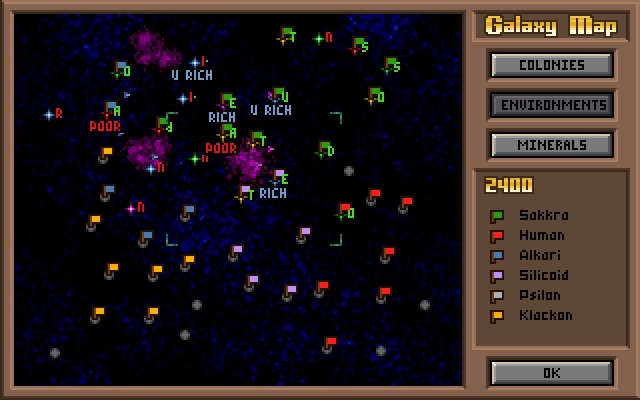
The Silicoids weren't interested in giving me that freedom of action. They went after Sssla next, and although I was able to get a missile base on my homeworld to meet their arrival, my pathetic tech situation made that missile base rather toothless. One base with Class I shields firing nukes doesn't stop much of anything. The Silicoids established superiority over the planet and then sent an invasion force. Fortunately it was only about 25m pop and I was able to beat that off without any trouble (the Silicoids only having Hand Lasers for gropo tech), but I was fighting ground combat on my homeworld, for heaven's sake! Not good.  The missile base had revealed something important though: the Silicoids only had lasers and Gatling lasers on their ships. If I could research Class II shields, that would be enough to make even one missile base invulnerable to their current designs. I built a base to near-completion on my homeworld, then went over to research. I did manage to get the shielding tech discovered in short order, finished a missile base, and chased away the Silicoid ships. OK, one crisis averted for the moment.
The missile base had revealed something important though: the Silicoids only had lasers and Gatling lasers on their ships. If I could research Class II shields, that would be enough to make even one missile base invulnerable to their current designs. I built a base to near-completion on my homeworld, then went over to research. I did manage to get the shielding tech discovered in short order, finished a missile base, and chased away the Silicoid ships. OK, one crisis averted for the moment.
Next the rocks shifted to targeting my Arid Poor planet off to the immediate west. There was no way that I could get a base finished on that planet any time soon with zero factories, and I tried to build a few ships to stop the Silicoid invasion. Since I was only interested in defending a single point and wanted to minimize attrition, I went with a Large design packing Battle Computer I, Class I shields, movement 2, a Battle Scanner, and about two dozen lasers. This was a solid design, but a pair of these was not enough to stop the Silicoid fleet that they had brought (a couple of Large ships with more of those Gatling lasers), and I retreated rather than lose the ships. That meant the invasion was on, as the Silicoids began sending transports against my Arid Poor world.
But you know what? This actually wasn't all that bad for me! The AI will leave its fleet in place over a world that it's trying to invade, and while the Silicoids kept adding additional ships to that stack, it wasn't moving to threaten any other location. Because these ships only had lasers on board, they were unable to do any damage from planetary bombardment, only occasionally killing 1m or 2m pop from orbit. And if there's any race that can handle those kind of losses, it's the Sakkra. The nebula that had been such a pain in moving to the south in the early game now became my ally, slowing the Silicoid ships and transports as they moved north. The first rock invasion landed 19m population, and was easily beaten off. The second invasion landed 35m population, and although more of a threat, was still defeated without much trouble. I used the Eco slider to regrow population after each attack, which combined with Sakkra natural fertility had the Poor world back up at max population long before the next Silicoid transports could arrive. My Poor planet was acting like a character with a taunt ability, soaking up the damage and keeping my other worlds from being targeted. As I said, this was actually working out quite well.
Meanwhile, my new colonies were starting to max out their factories and population, thanks to the time that my Poor world had bought me. The Rich and Ultra Rich planets to the north of Sssla were immensely helpful here; if you haven't played Master of Orion, it's difficult to put into words how helpful having even a couple of those planets can be. They maxed out very quickly and then began feeding their incoming into the Reserve every turn, allowing me to turbo charge the growth curve of all those other worlds in the far north. I was finally beginning to get some actual research done, now closing in on 100 turns into the game. The Humans were willing to trade me Terraforming +10 tech, a major help since my Planetology tree had no terraforming techs on the first three rungs. (The third tech was Controlled Toxic, no choice.) Improved Robotics III was also available at the second rung of the Computers tree, and that would be a major deal too, arriving just as most of the planets finished up with their initial factory construction. I even managed to get the Alkari to sign peace, although the Silicoids and Klackons remained intransigent.
Finally, with the help of my Ultra Rich planet assisting Sssla with shipbuilding, I was able to put together four of my Large laser design and kill the Silicoid fleet over my Arid Poor planet. It had been under siege for almost two dozen turns before I finally managed to chase the rocks away. In the end, therefore, I lost the Terran 120 planet and the Rich Dead world to the south side of the nebula, but I managed to claim everything else to the north, including that big cluster of planets in the northeast. All things considered, I'm pretty happy with how I managed things.
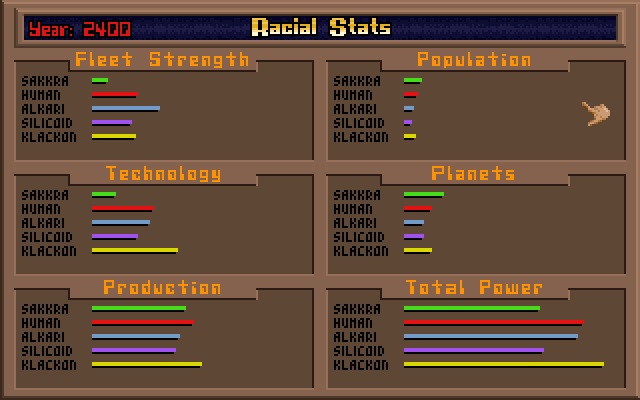
These were the bar graphs for the year 2400. I had 10 planets and looked to be able to claim the two Inferno worlds (one of them Ultra Rich!) in the northwest when Controlled Toxic finished in the near future. I was up against the Humans in the last Council vote, and had 8 out of 29 total votes (27%) to my own name. I had been pretty worried about this vote until I managed to get peace with the Alkari, who actually voted for me (heh) because they were at war with both the Klackons and the Humans. On the bar graphs, I was surprisingly competitive in Production, and I was hoping that I would start to pull away in Population soon due to my lead in planets and with the Sakkra's excellence in Planetology research. This would not end up being the case, but more on that in a minute. Note that my Technology rating remained completely pathetic; this was one of the worst tech performances I've had in a long time in a game where I wasn't simply wiped out in the first 75 turns. There were absolutely no resources to spare for research for a long time on end, with only my Poor second planet contributing 30-40 BC of trickle research for dozens of turns on end. It was what I needed to do to survive though, and my empire had barely managed to make it through the dangerous early game while still claiming enough planets to be competitive. However, playing from behind out of this deep tech hole would be no easy picnic, and this game was a long distance away from a winning position.
The Silicoids remained my biggest obstacle at this point in time. They refused to make peace no matter how many times I asked them for a treaty, and their incursions from the south were never ending in this game. I had managed to stave off their initial threat by researching Class II shields, which rendered my planets immune from their initial ship designs packing lasers and Gatling lasers. That would only last for so long, however, and it wasn't too long before the rocks were back with more advanced ship designs. Unfortunately they had researched Fusion Bombs at the second rung of Weapons tech, and that's always a serious danger any time the AI manages to research it. There's not much that early game shielding can do to stop bombs that deal 5-20 damage per shot. Luckily, the rocks didn't put together a dedicated Fusion design, instead slapping a few of them onto other designs (like their Colony ships, oddly) in bits and pieces. I was holding off the Silicoid ships pretty well until this design showed up:

That Polaris design right there spelled total doom for any planet that might be targeted. 40 Fusion Bombs on a Huge ship with 600 HP?! There was absolutely no chance that I could shoot that down with my missile bases (firing Hyper Vs) before it bombed out the planet in question. I had the worse luck to see this particular ship appear at Whynil, my Tundra Ultra Rich planet to the north of Sssla. There were about a dozen missile bases there, a strong defense for this point in the game, and it made no difference whatsoever. Wave goodbye to the bases over the strongest planet in my empire.
This is the kind of place where it's easy to get frustrated and give up on a strategy game. It takes real mental effort on the part of the player to keep grinding along in the wake of these setbacks; apparently I get this expression of complete and total concentration when I'm absorbed into games like this, to the point that I'm barely paying attention to anything around me. And I'm not presenting that as a good thing necessarily!  That said, I do enjoy challenges like this, and Master of Orion still delivers on the strategy front more than two decades after it was released.
That said, I do enjoy challenges like this, and Master of Orion still delivers on the strategy front more than two decades after it was released.
Anyway, so I needed to come up with a response to this situation. The colony at Whynil wasn't destroyed completely, only losing some of its population and factories. The Silicoids paused their small fleet over the planet while bringing in population for a ground invasion. That would take a little while due to the distances involved and the fact that the Silicoids only had warp 2 technology for warp 1 population transits. With Whynil being an Ultra Rich planet, I could easily rebuild the factories and then use Eco spending to regrow population, and I would have the planet remaxed very quickly from the bombing damage. But to what purpose exactly? I could build 3 or 4 bases in a single turn's worth of production... and that would be totally meaningless since they would fall prey to the Fusion bombs once again. No, what I needed here was ships, as that Silicoid Huge design had so many bombs on it that it had very little in the way of actual guns. As a result, I put my best nearby worlds (including my Rich planet) onto the project of turning out more of my Large laser gunships, and when I had six of them, I counterattacked at Whynil. This was rough going due to the Class II shields on the Polaris design, but I had close to 150 lasers firing on each round of combat, and some of them were going to get through. I managed to blow up the Silicoid Huge design, rebuild the missile bases, and shoot down the incoming Silicoid transports. For whatever reason, this was the only Polaris design that I saw in the whole game, and the rocks never put together another Fusion Bomb threat. Whew. Another bullet dodged.
The endless fighting that the Silicoids had done against me was also hurting them badly in the larger picture of the galaxy. The rocks had sent huge population invasions against my worlds over and over again, which is something that their race simply cannot do unless they're scoring big advantages in the process. Since I had managed to hold everything except the Rich Dead planet to the south of Sssla, the Silicoids had ended up with little to show for their aggression, and their growth curve had been decimated. They had fallen behind in technology, almost as far behind as I was, and a lot of their planets were starting to be snapped up by the other races. Especially the Klackons, who were dominating in tech and emerging as the top AI power in this galaxy. In the years following the 2425 vote, I began to look to go on the offensive against the Silicoids in the south:
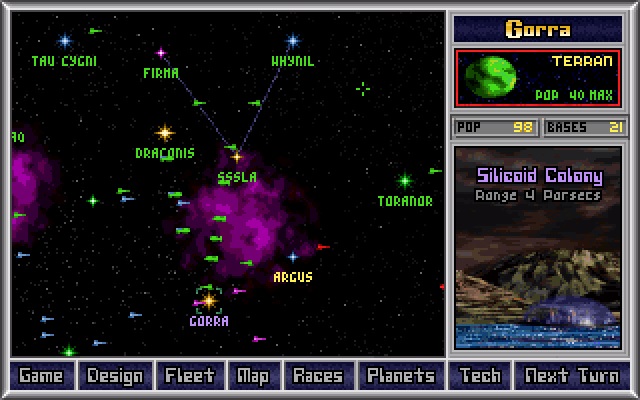
My targets were the same as they had always been from the start of the game, the Terran 120 planet of Gorra and the Rich Dead world of Argus. I had also researched Fusion Bomb technology, and once I had enough miniaturization I put together a Small design sporting one of those Fusion Bombs. I built them by the hundreds, and once I had close to a thousand I went after Gorra. Taking out the planetary defenses was easy, as the Silicoids lacked any kind of planetary shield. (I researched Class III Deflectors and then did have the Class V Planetary Shield available, fortunately. My Force Field tech tree was pretty generous this game, with the exception of lacking any of the Personal Shield gropo techs.) Now the more difficult issue was coordinating a ground invasion to capture the planet intact and then stand it up again. I was working with warp 2 engines, and that meant warp 1 transports. I also had to deal with that cursed nebula once again which slowed everything down even further. Sssla and Draconis (my Arid Poor planet) were sending a quarter of their population to Gorra every single turn for long periods on end, and regrowing them with the Eco slider. Because of the slow travel times, it was very hard to judge how much population to keep sending, and for how long to keep sending it. I came extremely close to taking the planet, only to have a random Alkari fleet chase away my ships and then shoot down the invading population. Then the birds sent their own transports and claimed the planet for themselves.
I wasn't ready to concede this location just yet, however. The Alkari had signed an alliance with the Klackons, and that brought them back into war with me once again. I had managed to make one extremely crucial trade with them before going to war though: I sent them Reduced Waste 60% in exchange for Scatter Pack V missiles. I knew that they were hurting badly on Construction tech, but still, wow, what a coup for me. My missile tech in this game was ABYSMAL: Hyper Vs, then no Hyper-Xs, no Merculites, no Scatter Packs, no Stingers, no Pulsons. I had traded the Humans something outdated for Hyper-Xs a little earlier just to have something a little stronger for my bases, but going up to Scatter Pack Vs was just huge. Even better, it was exactly the weapon that I wanted against the smarms of Small designs that the Alkari love to use. Maybe they should have considered that deal a little more closely before sending me a critical weapon that directly countered their own navy. 
Anyway, I continued invading the Alkari at Gorra turn after turn. You can see the transports still incoming on this map from 2450 if you look closely:
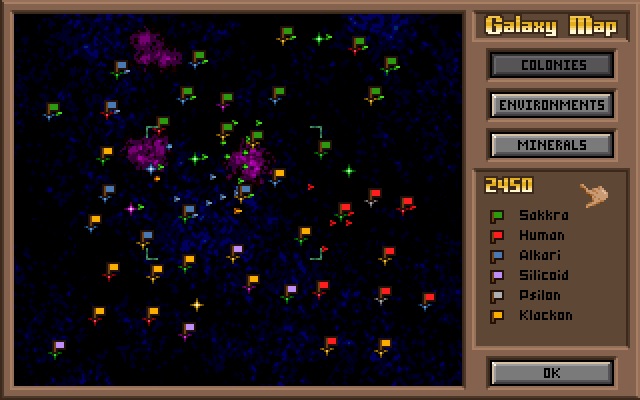
The birds had an edge in gropo tech; I don't recall the exact amount, I think it was +10 or +15 with another +5 for being the defender. While those are tricky odds to invade against, the rewards for a success would be huge as well. Conquering Gorra would give me a jewel of a planet in terms of size, and a secure strategic position on the other side of that obnoxious nebula. Even if I couldn't manage to hold the planet, Gorra had several hundred factories, and taking it would give me a chance to steal technology, which I badly needed. It's very difficult to keep up in tech on Impossible by doing your own research; only under the best conditions or with weak AI races is that possible. Normally, you will fall behind in tech and will need to play from a backwards position, requiring technology steals and successful invasions (again, with weaker ships and weaker gropo equipment) to stay competitive. In this particular game, I had fallen even further behind than normal due to my weak opening turns, and it was an uphill struggle the whole way to try and achieve tech parity. Gorra represented a huge opportunity for me, and I had to go for it.
As a result, I continued to feed millions of lizards into the meat grinder turn after turn. I was sending 40m each turn, 25m from Sssla and 15m from Draconis, which would kill about 15m Alkari each turn, more than they could regrow back on the interturn. I was slowly crushing them at a horrendous cost in my own population. This could have been thousands and thousands of research points if I were spending on tech instead of regrowing population via the Eco slider. Finally, I had the Alkari where I wanted them. Only 4m birds left, and the next turn would surely see me capture the planet. It was a long struggle, but it was worth it in the end... Wait, what's this? There was no colony present, and all the transports died due to lack of shelter? Huh? Well it turns out that a random Human fleet arrived at Gorra on the same turn as I did and bombed out the Alkari colony. Due to our Non Aggression Pact, we did not fight one another, and then my transports all perished due to the lack of a colony on the planet. You've got to be kidding me!!! 
That was frustrating to say the least. At this point, I decided to abandon this plan and shift tactics. Gorra and Argus were both spud worlds at this point in time, the hot potatoes both being wiped out routinely by the large AI fleets endlessly passing through this part of the map. I wasn't nearly strong enough to fight the AI navies for space superiority at this point, and I was forced to concede that I wasn't going to be able to control these planets. Here's one little strategic tidbit that I haven't seen commented on very much: the AI in Master of Orion tends to concentrate on the central parts of the map. Something about the way their pathfinding works in this game has them emphasizing the areas closer to the center much more often than the outer edges. That's only a general tendency, not an absolute rule, but I've seen that pattern over and over again. I decided that I would shift focus away from where those big fleets were moving around and head for more weakly held parts of the map.
Diplomatically, the Humans were a solid ally and had been the whole game. Due to that patch of empty space, we had little reason to quarrel with one another, and I was happy to keep things that way. The Silicoids were weak and I had been hoping to take some of their planets for myself. Unfortunately that project had failed, and now the Silicoids actually dropped out of contact with me, their few remaining planets too far away to the south. I didn't even have enough range to reach them now, much less invade them and capture technology. The Klackons had been at war with me the whole game, but up until now had been too far away for me to see many of their ships. That was about to change, and in a big way. They were way too far ahead in tech for me to think about invading them, however, and that left only one option for aggression: the Alkari. There were a couple of their worlds tucked along the western edge of the map, and it was those planets that I would shift my focus towards. If I could hold in the center of the map, I would try to roll up the western edge of the galaxy in a counterclockwise motion, limiting how many planets were exposed to AI aggression at any one point in time. Even better, I had scouted some of those Alkari planet in the early portions of the game, making invasions a bit easier. This would be my goal heading forward.
The Alkari sent swarms of their ships after me, but they weren't much of a threat. They were using mostly Ion Cannons and some Neutron Blasters on hundreds of Small ships, and I had enough planetary shielding that I didn't have to be worried about that. The new menace was posed by the Klackons, who were way out in front in technology and posed the most serious danger to my worlds. The former Silicoid worlds of Gorra and Argus eventually passed into Klackon hands, and that gave them enough range to reach my core holdings. I began seeing a routine stream of the yellow ships of the bugs. Their Weapons tech was a bit on the weak side though, and they didn't have much luck in cracking the shielding on my bases. At least, until they showed up with a dire new threat:

Death Spores.  Uh oh. I had enough shielding that the Hard Beams were irrelevant, but that wouldn't do any good against those bioweapons. Even worse, check out some of the other stats on that Ranger design: Class VII shields and 250 HP (Andrium Armor). The ship was completely impervious to Scatter Pack Vs, which only deal 6 damage per shot. The first time that I saw this ship in action, I traded for Merculites with the Humans, just so that I had some kind of missile able to damage these designs. As you can imagine, however, those Merculites were barely scratching the paint of these Rangers. I was able to survive this particular attack because there weren't enough Death Spores to kill off the whole planet's population, but I desperately needed an answer for this new threat. The bugs were able to leapfrog from the former Silicoid worlds in the center of the map up to the northeast corner, which had been safe from any invasions to date, and they dropped their filthy bioweapons all over the planet of Klystrom, killing every lizard on the surface. The factories would remain there when the colony was rebuilt, but I had just lost another strong planet. Worse yet, if the bugs were able to set up shop in the northeast corner of the map, they would have the range to strike essentially my entire empire - nothing would be safe.
Uh oh. I had enough shielding that the Hard Beams were irrelevant, but that wouldn't do any good against those bioweapons. Even worse, check out some of the other stats on that Ranger design: Class VII shields and 250 HP (Andrium Armor). The ship was completely impervious to Scatter Pack Vs, which only deal 6 damage per shot. The first time that I saw this ship in action, I traded for Merculites with the Humans, just so that I had some kind of missile able to damage these designs. As you can imagine, however, those Merculites were barely scratching the paint of these Rangers. I was able to survive this particular attack because there weren't enough Death Spores to kill off the whole planet's population, but I desperately needed an answer for this new threat. The bugs were able to leapfrog from the former Silicoid worlds in the center of the map up to the northeast corner, which had been safe from any invasions to date, and they dropped their filthy bioweapons all over the planet of Klystrom, killing every lizard on the surface. The factories would remain there when the colony was rebuilt, but I had just lost another strong planet. Worse yet, if the bugs were able to set up shop in the northeast corner of the map, they would have the range to strike essentially my entire empire - nothing would be safe.
I should mention that this was the first Master of Orion game that I played using kyrub's unofficial patch. I needed to download it to take part in the succession game at Realms Beyond, and it wasn't worth the trouble to try and uninstall it afterwards. Kyrub's patch makes no changes to gameplay, focusing instead on cleaning up a number of bugs and improving the AI's performance with some small tweaks in the programming. The biggest change that I've noticed in this patch lies in AI ship design. In classic Master of Orion, the AI is infamous for overloading its designs with weapons and then crawling around with huge fleets at warp 1 and combat speed 1, making it easy to dance around them. AI ships also too often lack proper shielding or enough attack level to be effective. Kyrub's patch seems to fix these problems, and all of the Klackon and Alkari ships were now zipping around at warp 5 or warp 6 speed. This makes it much more difficult to stop AI attacks, as the player gets a lot less time to see the threats coming and react accordingly. The AI also seems to be using a lot more tactical combat speed and heavy shielding on their ships. Basically the designs are just a lot better all around, and that made this even harder for me to deal with compared to what I was used to.
While the Klackons continued to pressure me, I had been preparing an invasion of the Alkari world of Nitzer. This was a planet in the far northwest corner of the galaxy; in the 2450 picture above, it's the northernmost blue flag up in that corner. I coordinated a massive invasion of this planet, sending over 250m population timed to arrive on the same turn as my small fleet. Thank goodness I had scouted this world in the early stages of the game to make this possible. True to form, here in this backwards corner of the galaxy there were few Alkari ships for defense, and I was able to capture the planet. One of the captured techs was enormously significant:
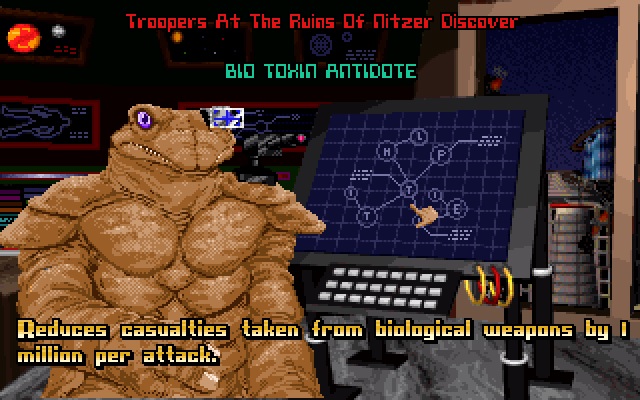
Bio Toxin Antidote, yes!  That removed the threat of those Death Spores that the Klackons were packing, and this arrived just in time to save me from total disaster. Over the following years, the Klackons would drop thousands and thousands of those bioweapons over my planets, with my missile bases completely unable to shoot them down. In fact, eventually the Klackons began sending a ship that had Class XI shields against my worlds, which my Merculite bases were literally unable to hurt with their 10 points of damage. Without capturing this antidote technology, I probably would have lost the game. I had already lost one planet in the brief period between when the bug started fielding these things and when I managed to get the antidote. I don't want to think about what would have happened if I hadn't found this on a captured Alkari world.
That removed the threat of those Death Spores that the Klackons were packing, and this arrived just in time to save me from total disaster. Over the following years, the Klackons would drop thousands and thousands of those bioweapons over my planets, with my missile bases completely unable to shoot them down. In fact, eventually the Klackons began sending a ship that had Class XI shields against my worlds, which my Merculite bases were literally unable to hurt with their 10 points of damage. Without capturing this antidote technology, I probably would have lost the game. I had already lost one planet in the brief period between when the bug started fielding these things and when I managed to get the antidote. I don't want to think about what would have happened if I hadn't found this on a captured Alkari world.
Not only was I behind in technology this game, I also had some nasty holes in my tech tree. That's to be expected in Master of Orion, but this game was particularly harsh in a couple areas. I've already mentioned how I couldn't find a single missile other than Hyper-Vs, and had to trade or capture everything else that I used in this game. My Construction field also suffered from serious gaps, as I kept getting nothing but Improved Industrial techs. There was II9, II8, Reduced Industrial Waste 60% (which was quite useful), then II6. There was no armor in particular: no Duralloy, no Zortrium, no Andrium. My ships and missile bases were still sitting at the default health over 150 turns into the game. (This also made my ground combat situation even worse.) This was a painful shortfall that left my defenses weaker than they would have been normally.
But the worst of all was Planetology. I missed out on all of the standard Terraforming techs - all of them! I was missing +10, +20, +30, +40, +50, and +60 Terraforming - and no Soil Enrichment either! It requires some terrible luck on the dice rolls of what techs are present to miss that many terraforming techs in the same game. I had traded for +10 Terraforming in the early stages of the game, and then tried to steal +20 or +30 from the Silicoids for ages on end, never having any success. My Computers tech was roughly comparable to theirs, I guess I was just unlucky over a long period of time. The inability to get any significant terraforming going was holding my empire back in the worst way. Now because all of those techs were missing, I had plenty of Hostile planet techs available (I researched Controlled Dead, Toxic, and Radiated) plus I did manage to research Atmospheric Terraforming, a big deal with my many Hostile planets. Nonetheless, this was hurting me in the worst way, as the Klackons had Advanced Soil Enrichment along with Terraforming +50, which was causing their planets to average about double the size of mine. What a cruel streak of poor tech luck.
Wait a minute, you might be saying, aren't the Sakkra rated Excellent in Planetology research? Shouldn't they be more likely to have techs available in that field than normal? Not so much as it turns out. Sirian's website is wrong in this regard: Excellent/Good/Poor status in a tech field has no effect whatsoever on whether techs will be present or not. It's a straight 50/50 shot on whether a tech will appear, with the game making sure that at least one tech is available to research on each rung of each tech field. The only exception to this rule is that the Psilons have 75% odds for each tech to appear, which is part of their unique racial ability. That's it. I'm actually disappointed that the game doesn't make techs more likely to appear for races rated Excellent in a field and techs less likely to appear for races rated Poor in a field. That's such a neat idea, it's too bad that the game doesn't actually work that way. It doesn't though, and my Sakkra were no more likely to have a fertile Planetology field than the Meklars. Of course the techs are much cheaper to research for the Sakkra than the Meklars, but that doesn't affect whether or not the techs are present in the first place.
I bring this up because right at the same time that I seized the Bio Toxin Antidote from the Alkari, I also managed to swing this trade with the Humans, on the same turn actually:

Wow, Terrarforming +50 technology! That was exactly what I needed to boost my economy. The tech trades that I made with the Humans really helped me out in this game; I'm trying to remember what I sent them for this tech and I can't recall quite what it was. Something that I looted from the Alkari, I think. I had Advanced Soil Enrichment underway, and the combination of +50 Terraforming and Gaia planets would remove any possibility of a Council loss, not to mention let me stand up hundreds of additional factories on every planet. If there was a single turning moment in this game, it was landing these two techs at the same time.
Here was the new tech in action on the following turn:
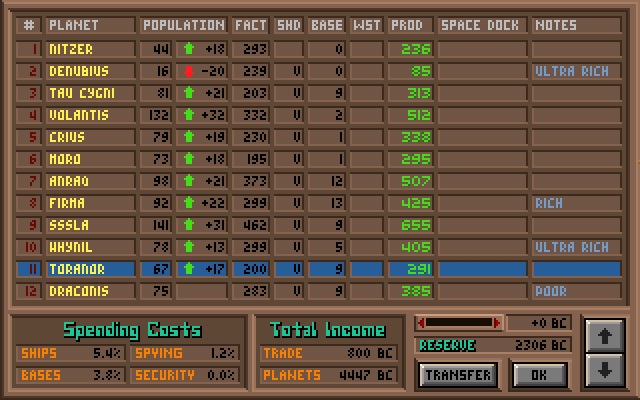
Look at that population growth in action. I would be going from +10 Terraforming to +50 Terraforming, allowing an extra 40m lizards on each world. That was great everywhere, with big planets like Sssla going from 110 pop / 440 factories to 150 pop / 600 factories. It had a more dramatic effect on planets with smaller base sizes, like Ultra Rich Whynil going from size 65 to size 105. Although I don't know the exact change in Total Income, it was a substantial improvement across the board.
Notice as well that the Ultra Rich planet of Denubius was decreasing in population from the prior turn. The Alkari had been invading me there, and you would think that an Ultra Rich planet would be able to hold them off via missile bases without any trouble. I thought the same thing, only to find out that the planet was apparently located in a nebula where the planetary shields didn't function. That's not how it looked on the galactic map, where Denubius appeared to be outside the purple nebula cloud, but apparently it was close enough. My missile bases were unable to shoot down the hundreds of Small ships that the Alkari brought, and then they began sending population transports. With their advantage in gropo tech, this posed a major risk to the planet. I realized that I was going to lose Denubius unless I did something to change the situation, and winning a fleet to fleet battle in a nebula was out of the question. Ultimately I resolved the situation through diplomacy; since I had just whacked the birds at Nitzer, they were willing to sign peace if I kicked in 1000 BC as part of the deal. Done! This move both saved Denubius and also allowed me to stand up defenses at Nitzer, which I would not have been able to hold agains the avian fleets otherwise. This peace treaty once again allowed me to narrowly escape a dangerous situation.
That left me at war with only one opponent: the Klackons. They had managed to kill the population of only one planet, Klystron, before I gained access to the Bio Toxin Antidote. Klystron was in the isolated northeast corner of the galaxy, and I feared that the bugs would dig in and establish a fortified presence there. They ended up founding a new colony there, which was wiped out by the Humans a couple of times via population invasion, and vice versa as the two of them squabbled back and forth. However, the factories still remained on that planet since they had never been bombed out of existence. I soon spotted an opportunity: the Klackons had sent their fleet off to the south, and Klystron was sitting around unguarded with only 10m population present. Klystron was near three of my own planets, and I had them immediately send population to try and recapture the location for myself. Even with a disadvantage in ground technology, this worked as I had hoped:
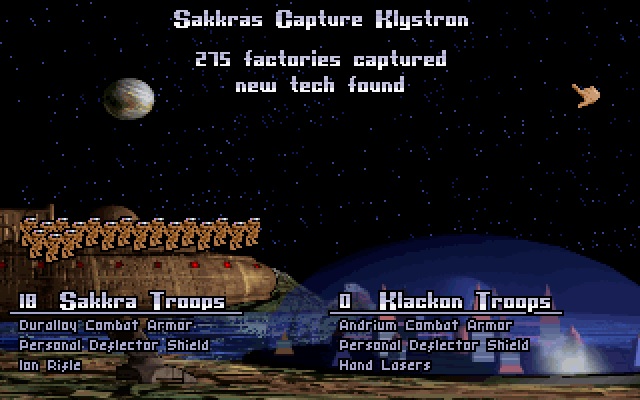
With 275 factories still sitting there, I was guaranteed to pull several techs in the invasion. This can be somewhat of a rules loophole, if the player deliberately allows the AI to capture a planet with the intention of taking it back to gain more techs. I had done nothing of the sort here, of course, and I was hoping to rebuild the defenses of Klystron and bring it back into my empire again. Still, the payoff for taking those factories was huge:

Class XV Planetary Shield, sweet! I was in the process of researching the Class X Planetary Shield at the time, which should give you an idea of how far ahead the Klackons were. At least 10 tech levels ahead, and probably more than that. I didn't screenshot the rest of the techs, but one of them was an even greater haul: I also picked up Andrium Armor (more than doubling the HP of my bases and ships) and the Black Hole Generator. Holy cow!  That's a tech level of 42 in the Force Fields tree. As I said, I was researching Class X Planetary Shield, which is, umm, tech level 22. Talk about an upgrade to my shielding tech. I almost never get this far into the Master of Orion lategame, and I had no experience at using this special previously. According to the official description, the Black Hole Generator kills 25-100% of targeted enemy ships, with deflector shields reducing the kill ratio by 2% per level of shields. This is a NASTY weapon from the lategame, and I planned to give it a spin and see exactly what it could do.
That's a tech level of 42 in the Force Fields tree. As I said, I was researching Class X Planetary Shield, which is, umm, tech level 22. Talk about an upgrade to my shielding tech. I almost never get this far into the Master of Orion lategame, and I had no experience at using this special previously. According to the official description, the Black Hole Generator kills 25-100% of targeted enemy ships, with deflector shields reducing the kill ratio by 2% per level of shields. This is a NASTY weapon from the lategame, and I planned to give it a spin and see exactly what it could do.
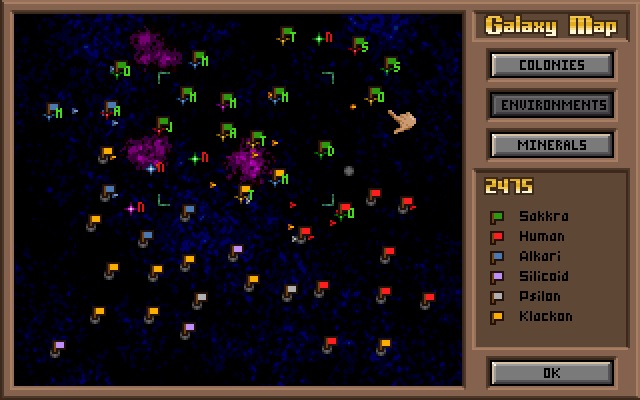
This is about the point in time when I started taking a lot more screenshots, right when I decided that this wild game simply had to be captured in a report. This overview map from 2475 highlights how the galaxy was increasingly being divided between Sakkra, Klackons, and Humans. I have the hand pointing to the location of Klystron, which would once again secure the northeast corner if I could manage to hold onto it. The bugs had more population transports on the way to take it back, but I would continue flooding the planet with population from the two nearby Steppe planets to fill out those factories. With Reserve spending and that new Planetary Shield XV tech in hand, I was able to get a missile base up and running before the Klackons could take the planet away from me again. They actually had a small group of ships show up again and establish space superiority, with my fleet far away on the western edge of the galaxy, and I kept right on sending more population from the nearby worlds. Some of the lizards were shot down, and yet enough made it through to keep filling up the planet and working those pre-existing factories. Once I had a missile base up, that was pretty much it as far as threats to Klystron went. The northeast corner went back to being a backwater region, largely powering my research efforts while other worlds closer to the front lines concentrated on ships and missile bases.
I was focusing my efforts over in the west. The Alkari had returned to war with me again, pulled into the conflict by their alliance with the Klackons, and they were the obvious target for expansion. By contrast, I couldn't even crack the Klackon base defenses with their 25+ points of shielding. I did have Omega-V bombs in my Weapons tree, and I was heading in that direction. For the moment though, it was just the good old Fusion Bombs, which weren't going to cut it against the bugs. The Alkari though, they were a lot less advanced in technology. I combined the new looted technology from Klystron together with Fusion Drives (warp 4) engines to create this design:

This is your standard Huge Autorepair gunship design... just without the Autorepair special at the moment. I had skipped it earlier in favor of Reduced Waste 60% tech, and I was now backtracking to pick it up. In the meantime, this design was intended to establish space superiority against the birds by stacking up heavy shields (Class VI) and putting that Andrium Armor to good use. I opted to limit this ship to only a movement speed of 2 in combat so that I could cram even more guns on board, using the Fusion Beam as my frontline weapon. I don't often limit my ships to only two tactical movement, but this design was purely intended for ship to ship combat, and had no need to close with an enemy planet for bombing. I also added the Black Hole Generator to see what it would do in combat, and it proved to be very strong against the swarms of tiny ships that the Alkari were fielding. In addition to this design, I also created a Small ship with Fusion Bombs designed to eliminate the Alkari missile bases. They had Scatter Pack V missiles, but enough bombers should be enough to get the job done, with losses of course.
If you look back at the overview map above, I was targeting the two northern Alkari planets in the west. The Arid planet was Kronos, a Poor planet that was weakly held with only 5 missile bases. The Minimal planet was Quayal, formerly a Radiated 10 planet that I had terraformed to Minimal environment via Atmospheric Terraforming. Of course, right after I did that it was taken away from my by the birds, since I couldn't defend the world from their much larger fleets. Should have build the missile base first I guess, although that would have taken an eternity on a size 10 planet without doing any terraforming. Because the AI struggles to deal with tiny planets, Quayal was also very weakly held; I think it had something like 30 factories and zero missile bases. These were ripe targets to pursue for conquest.
Over the following two dozen turns, I built up a legitimate fleet for the first time and slowly took over these two planets from the Alkari. The tricky part here wasn't invading the planets themselves, as I had enough firepower to get past the Alkari missile bases and enough ground troops to overwhelm their populations. The harder problem was securing these two worlds post-capture, building up the factories and flipping them around into secure positions. At Poor Kronos, I just made sure to get one missile base up so that the planetary shield could do its job. I built factories as best I could while not expecting ever to finish before the game ended. (I always try to stand up Poor planets and not use them solely for population/research; my Arid Poor second colony did eventually max out in factories in this game, and that allowed it to fend off many attacks that would otherwise have taken the planet.) While Quayal didn't have the Poor penalty, it was working off of a tiny starting size and required a lot of investment to get up to speed. I held my fleet in this part of the map for safety, not least because the next planet to the south was a Klackon world and would not be such easy pickings.

Here are the bar graphs following the 2500 Council vote. I had held a one-third veto block starting in the 2475 election, ever since getting my hands on the combination of Terraforming +50 and Advanced Soil Enrichment. By this point in time, I had managed to catch the game leader in Production, and was approaching the Klackons in Total Power, even if Technology remained well out of reach in this game. The bugs had rolled a Diplomatic personality in this game, and their teching was totally out of control during this game. (I would find out why later on.) If I could manage to start cracking their planets and loot some more of their fabulously advanced techs, that would be the edge I needed to put this game to bed.
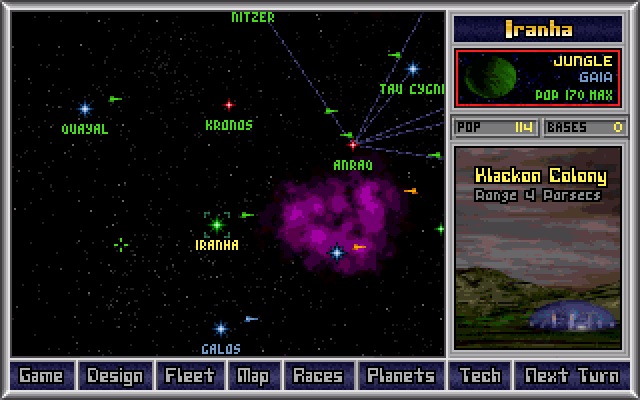
The best location for that was Iranha, the Klackon world to the south of Kronos and Quayal. My long-running plan to roll up the western edge of the galaxy was working so far, and I saw no reason to stop now. Iranha would be a difficult target though, as the Klackons had managed to research up to +100 Terraforming at this point, and all of their worlds were enormous. For example, this planet had about 65 missile bases and an eye-popping 31 points of shielding from Class XX Planetary Shield and Class XI Deflectors. Geeze, Klackons! The bugs had nearly maxed out all of the tech fields in just 200 turns, and on a Standard-size map, not a Huge one. Xenophobic Diplomats indeed in this game.
I had finished Omega-V Bombs by now, and that gave me a tool to deal with those defenses. They deal 20-50 damage per bomb, enough to cut through that heavy shielding and injure the missile bases. Unfortunately the Klackons also had Adamantium Armor at this point, which meant missile bases with 175 health apiece (they start with only 50 HP each at the beginning of the game). At least the bugs only had Merculite missiles and nothing better, one small break of good luck. I designed a Medium ship packing three Omega-V bombs, with a combat speed of 3 and the maximum attack level that I could manage. When I had about 350 of them, representing roughly 1000 total Omega-V bombs, I went after Iranha along with my Huge gunships sporting the Black Hole Generator special. The bombers took nasty casualties closing with the planet, and I was down to about 150 of them before I dropped my first load of bombs... which killed only 10 missile bases. Uh oh. I would have needed to retreat from this battle with my tail between my legs, except that my Huge gunships with their Black Hole Generators began destroying the missile bases themselves. I had no idea that the BHG special even worked against missile bases, and wouldn't have known to try if the Klackons hadn't created a ship with the BHG that attacked some of my own bases. (Inexplicably they retreated from that battle even though my own Merculites couldn't damage their ship with Class XI shields. Lucky break for me.) I had two different Huge designs with the BHG special on them, and between them they were killing 5-10 missile bases each round of combat. As a result, even as all of my Omega-V bombers were slaughtered by the defenses of Iranha, the Huge gunships managed to get the job done and establish space superiority over the planet.
The picture above was taken after I had already knocked out the defenses, as otherwise I wouldn't have been able to view the population level. Now I could send marines in transports to try and capture the planet, and that was going to be even more difficult. The Klackons were very far ahead in ground combat technology; they had Adamantium Armor to my Andrium Armor (+10), Personal Absorption Shield to my Personal Barrier Shield (+10), and Powered Armor to my Battle Suites (+20). The only place where I had an edge was with my Ion Rifle against their Hand Lasers, and that advantage was wiped out due to the innate bonus for their race being the defender. (This would have been even worse if I hadn't looted Andrium Armor from these very Klackons earlier, and the Personal Barrier Shield from the Alkari in one of my other invasions. My gropo technology was beyond awful in this game.)
Invading another planet when the defender has an advantage of 40 points in ground technology is extremely difficult to pull off. You can expect to suffer roughly 4:1 or 5:1 casualties when facing this kind of a disadvantage. Trying to conduct the invasion against a planet with over 100 defending population starts to verge on the suicidal. This is about the limit of what I will try before throwing up my hands and concluding that a ground invasion is impossible. At the same time, however, the advantages for pulling off a successful invasion would be equally enormous. Not only would I get another gigantic planet to bolster my empire, one where it would be trivially easy to stand up defenses and form an impregnable fortress, I would also surely pull the maximum of six techs, each one a lottery ticket with the possibility of reducing the Klackon edge in research. Just as I had tried to pull off a similar invasion against the Silicoids earlier in the game, I had to go for the same deal here.
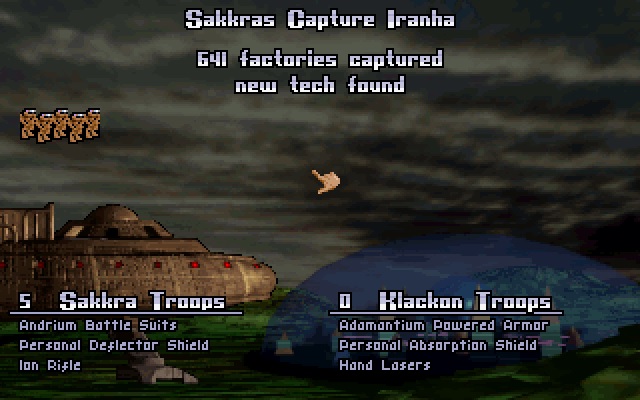
The resulting slaughter was truly horrific to behold, even in a make-believe game about space empires with anthropomorphic lizards and birds. I was sending 25% of the population of every planet within 12 parsecs range off to the battlefields to be slaughtered, each and every turn for about 8 turns in total. One quarter of a planet's population is the most that can be grown back in a single turn, and I was sending that off to fight and die and be regrown each turn. At the height of my invasion, I was landing about 160m population every turn, and doing that turn after turn after turn, killing about 25m defenders and seeing some of them regrow between turns. (Iranha was a Gaia world of course.) At least if there's one race that can pull off these kinds of stunts successfully, it's the Sakkra. Life if cheap amongst the love-happy lizards. All told, I suspect I threw about 1000 total population points against that blasted Klackon planet. But those repeated waves did achieve their goal eventually, leading to the following tech haul:
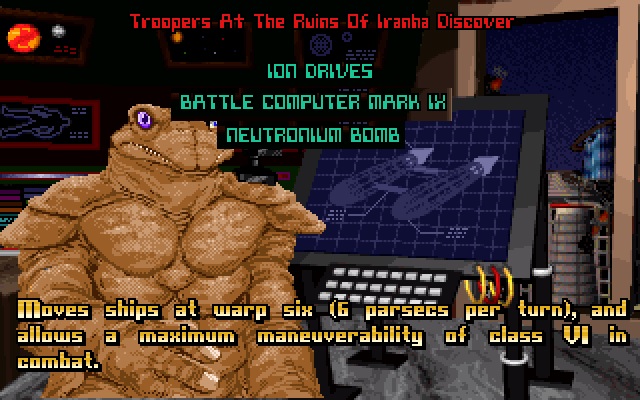
I did get the maximum six techs, with these three being the most significant. Ion Drives were a great prize, taking me from warp 4 to warp 6 and opening up the all-important tactical movement speed of four points. That allows bombers to close to the planet's surface in just two turns of movement and cuts down on casualties significantly. Battle Computer IX was another huge upgrade - I think I was at BC V at the time - and it would bolster my spying efforts against the other races. If there was something I wanted from the Alkari or Silicoids, I could take it now. Best yet were those Neutronium Bombs, the top bombs in the game. They deal 40-70 damage and have a tech level of 38. If this wasn't quite as great as popping the Black Hole Generator earlier, it still jumped me up about a dozen levels of Weapons tech, making everything else in the field cheaper and smaller to build.
With 600+ factories already intact, Iranha was a cinch to build its own planetary shield followed by enough missile bases to be secure. The Klackons had finally stopped targeting me in favor of clashing with the Humans, likely realizing that I had enough shielding to stop their ships from doing very much. On the other hand, if they ever started building something with those Neutronium Bombs, I could be in some real danger. I needed to continue pressing the offensive, and this ship would help me out there:
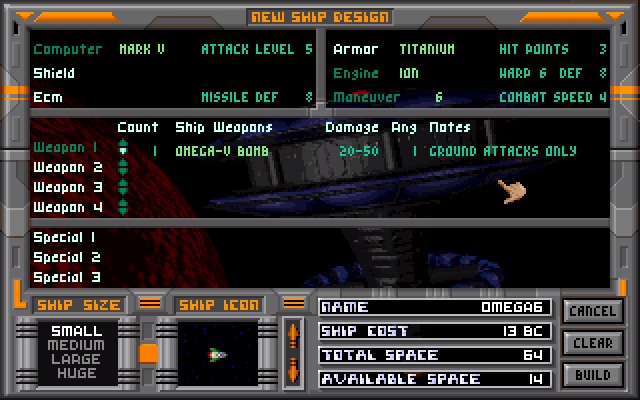
If you're ever curious about seeing miniaturization in action, here's a textbook case. That's an Omega-V bomb on a Small hull, with warp 6 engines and a combat speed of 4. On top of that, I've also even managed to fit a Battle Computer V on there for enough attack level targeting to be effective. This whole thing costs just barely more than an unarmed scout at the beginning of the game. With the vastly larger planets and higher levels of Robotic Controls that I now had available, my top planets could crank out about 100 of these ships, each, per turn. And with Master of Orion's stacking mechanics and easy RELOCation orders to the front lines, this game makes it easy to manage thousands of ships at once with very little tedium. Master of Orion does this better than any other empire-building game that I've ever played.
Using my new toys, I ran over two more Alkari worlds further to the south, including Altair itself. I left them with one planet for the moment, not wanting to trigger the genocide diplomatic penalty. I just needed to hold the vote of the Humans and I was confident that I could win at the next Council vote, although my enormous size was now starting to cause some diplomatic strains. Bombing the Klackons some more would take care of that.
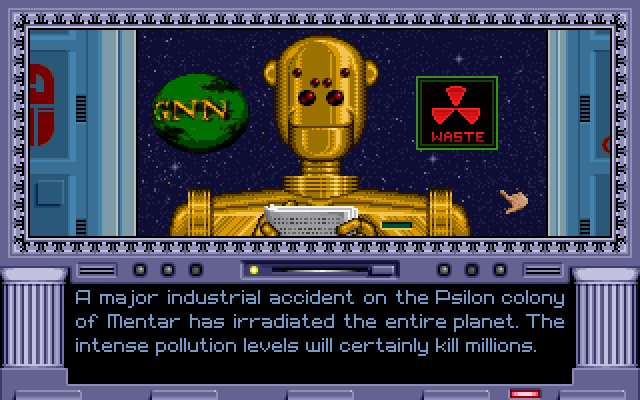
Master of Orion can be a cruel game sometimes. Yes, the Psilons were present in this game, although I'd never had much contact with them and they had been stunted from the beginning. They were running some One Planet Empire at the moment on just their homeworld of Mentar. Well, it seems this galaxy really had it out for them, as they drew the Radiated event on their one and only planet. That was just a jerk move, Master of Orion! Bad game, bad!  Because this is such an old game, it has no concept of playing fair or trying to balance things out to help the weaker powers. In today's gaming environment, it's actually refreshing to see a strategy game that has this kind of brutal setup, if only as a change of pace. Poor Psilons.
Because this is such an old game, it has no concept of playing fair or trying to balance things out to help the weaker powers. In today's gaming environment, it's actually refreshing to see a strategy game that has this kind of brutal setup, if only as a change of pace. Poor Psilons.
The one thing that I hadn't discovered at Iranha was an improvement to my ground invasion technology. That meant another slaughter at the next Klackon planet in line, although fortunately Kailis was a slightly smaller planet and with warp 6 engines I could pull population from more of my own planets without suffering from long travel times. This is the one part of Master of Orion's gameplay that I do find tedious, needing to queue up so many population transports to do invasions in the latter stages of the game. It's a major reason why I almost never play on Large maps, and why I refuse to play on Huge maps. Too much micromanagement to no real purpose. After several turns of landing over 200m pop in each assault, I captured Kailis as well along with a treasure trove of advanced technology:

Just look at all those goodies. Adamantium Armor and Powered Armor (which I failed to capture in a screenshot) added +30 to my ground combat rolls. The Klackon advantage was completely gone in that field now, and any future invading would be done from a position of parity. No more of those hideous 5:1 casualties, with lizards dying in droves for every bug rooted out and destroyed. The Advanced Space Scanner would make it easier to conduct invasions as well, sending population ahead of time without needing to remove the missile bases. I was now moving into parts of the galaxy where I had never scouted in the early game, and that thing would come in very handy.
The irony of all this is that I didn't need to conduct any more planetary invasions. Capturing +100 Terraforming technology rendered all that gropo technology a moot point, as I could now add 50m population on all my planets and that along with the Human vote in the Council election would surely be enough to put me over the top. The Klackons were widely detested in this galaxy from running over so many other races, and the Alkari were the only ones who liked them. With the calendar date sitting at 2520, I simply needed to dial up the Eco spending and terraform all my planets with the new captured technology. Here's that process under way:

Gaia planets plus Sakkra fertility makes for a serious lizard infestation problem. Some of the stronger worlds hit the full 50m in a single turn! Well, perhaps I overspent a little on the Ecology slider, but it's still impressive nonetheless. Even the newly captured world of Kailis was getting in on the act.
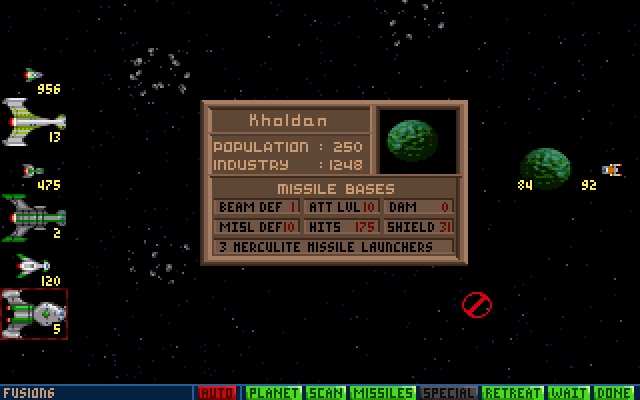
To ensure the Council vote from the Humans, I opted to bomb the next two Klackon worlds. Fittingly, one of them was Kholdan itself, which I confronted with my whole fleet here on the 2524 interturn. The bugs had 250 population and 84 missile bases, which did a good job of trashing the stack of 956 Omega-V bombers that I brought to this party. Most of them ended up perishing in this battle despite my best efforts. However, all three of my Huge gunship designers were packing Black Hole Generators, and they pummeled the planet repeatedly turn after turn, eventually destroying the bases without taking further losses. After having a game to experiment with the BHG special, I recommend it in very high terms. That thing is one deadly weapon, especially against stacks of Small ships. The Alkari fared very poorly against it, and even the Klackons mostly seemed to avoid my fleets, although that might have been because I was hugging the edge of the galactic map. If I get this thing again, I plan to use it.
After taking out the defenses of Kholdan, I bombed the planet heavily, although one turn of orbital bombardment wasn't enough to destroy it completely. That meant it was still standing as a shattered hulk of a world at the time of the 2525 Council vote:

The Klackons had 17 votes to their name, and pulled the single vote that the Alkari still had left. I picked up votes from the Psilons and the Silicoids (hah!) along with the 14 votes held by the Humans. I calculated this just about right, hitting the Klackons as much as I could without dropping them behind the Humans in population. Then the vote would have split and the game would have continued. With victory a foregone conclusion, I was very happy to take a Domination victory here with 38/75 of the total votes (51%). The Humans remained my steadfast ally throughout the whole game, and I'm glad we never came to blows.

Here's the final galactic map, with the cursor pointing to Kholdan. Altair is just to the north under the Sakkra colors, and Cryslon along with (Radiated) Mentar off to the east. Those four AIs started very close together, and it took a little while for the Klackons to emerge as the big power from this group. The secret to their teching prowess was also revealed at least: a pair of Artifact worlds right next to Kholdan! No wonder they were burning up the tech ladders. It looks like the Klackons managed to lock the Psilons out of the nearby planets and left the brains stunted, then slowly built their power over time through technology due to those Artifact worlds and their Diplomat strategy. Based on this map, the Humans look to have had the best draw, and it's somewhat surprising that they didn't emerge as the top AI power.

And the final bar graphs. Note that I have taken the lead in Total Power for the first time, and true to form, Master of Orion lets me cash out with a victory at the next Council election. This game is finely tuned like a professional orchestra in that regard. No other strategy game does it better.
I wasn't planning on writing about this game, but it turned into such a wild ride that I simply had to chronicle it while my thoughts were still fresh. From the start of the game with all those Hostile planets surrounding me and a Poor planet as the second colony, to the endless attacks from the Silicoids that I barely managed to stave off, including fighting on Sssla itself, to the failed invasions in the center of the map that wasted so many of my resources, to the Klackon bioweapons that I was able to stop through a timely capture of the antidote tech from the Alkari, to the crucial tech trades that I was able to line up with the Humans to solve some of my tech gaps, to the ridiculous slaughter of Sakkra lives in planetary invasions, to finally capturing the key technologies that I needed after being pathetically backwards for the vast bulk of this game... it was quite an uphill struggle. I think I'll remember this one for a while, and I hope that you do too. As always, thanks for reading.



